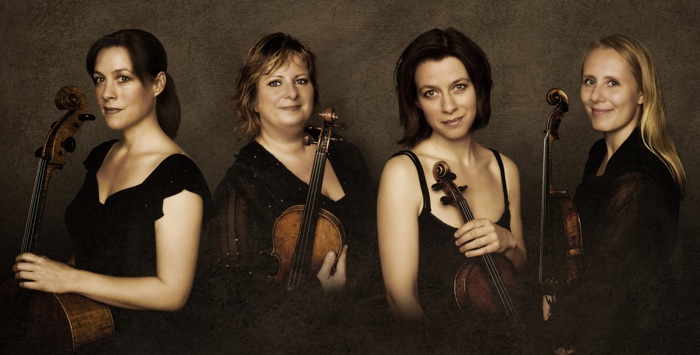Stellar quartet graces Stanford
A less-than-capacity crowd greeted the Vertavo String Quartet at Stanford’s Dinkelspiel Auditorium last Wednesday, January 26. But those that came were rewarded with a rare appearance by one of Norway’s top quartets. This all-female quartet is the winner of Norway’s coveted Grieg Prize, while their CD’s have won France’s Diapason d’Or and European Grammys.
But first we were warmed up with a short dance program. Jenny Bilfield, director of Stanford Lively Arts, explained that this is the second season of student-curated opening acts, addressing the bridge between talent and professionalism.
Stanford’s Bent Spoon, a student-run modern dance group, is the first dance program to be part of this experiment. Playful choreography and serious themes were underlined with curious geometries. “Corner” had hand gestures as expressive as Hawaiian story telling, fingers fluttering against bird trill and then turning internal with nesting gestures. Using slow abrupt angles, “The Three of Us” explored parallel play and isolation. These dancers’ language may be less polished, but what they had to say was worthwhile.
And then, celebrating 25 years since their professional debut as hard-working teens, the Vertavo brought high energy and huge warmth to a wide-ranging program. They began with Joseph Haydn’s late work, Quartet No. 68 in D Minor, an unfinished two-movement work that contains all the gentle camaraderie of a long life—he was 71 when he wrote this.
The Vertavo rendered it with care and wit. After a leisurely exchange four deep chords marked a transition to a faster minuet. Deeply bowed moments marked the elegant second movement as well, variations whose dynamics passed from pianissimo to forte in a flash. There was a wistful quality in the work, particularly in the viola part, played by Henninge Landaas, reminding us that Haydn was well aware that this was one of his last compositions.
They moved up a mere hundred years, from 1803 to 1911, to Leoš Janáček’s On an Overgrown Path. But it is not possible to describe the musical journey that began with Beethoven’s teacher and ended with these modern miniatures. The string quartet version of these piano works kept the fragility and inwardness, filling out harmonies without sacrificing the lonely truths. Naše večery (Our Evenings) lent a softness to the air, while Pojďte s námi! (Come With Us!) was simply joyful. Bows skated over the strings, risking ghost tones. In the Madonna of Frydek mutes created a murmuring ground under first violinist Øyvor Volle’s simple melody.
And then they swept forward another hundred years into Leyendas, an Andean Walkabout (2001) by Berkeley’s own Gabriela Lena Frank. A work of violence and beauty, Leyendas balances contemporary treatment with ancient Peruvian folk melodies. This six-movement work was at the heart of the concert, and displayed the remarkable diversity of sound and unity of intent of the Vertavo players. Along with violist Landaas and violinist Volle was Berit Cardas as second violin and Bjørg Værnes Lewis on cello. Cardas supplied the lower dimension of the violin, but was by no means a “second fiddle,” and it was not surprising when she traded seats to play first violin after intermission. That equality was a hallmark of their sound, reminding one of the Brentano or Del Sol String Quartets, and replacing virtuosity with richness and a shared love of the edge.
After that long first half, they returned for Beethoven’s mighty String Quartet No. 13 in B-flat Major, written in 1826, just one year before his death. The Vertavo subtly exaggerated Beethoven’s already-smoking dynamics for bite that any contemporary composer would envy. Their reading was as skilful as it was passionate—the gentleness of the Andante, the deeply pensive Adagio and the formidable Finale were, simply, gifts.
Stanford Lively Arts continues a top-notch array of jazz, classical and dance programs. See livelyarts.stanford.edu for current listings.
—Adam Broner
Photo of the Vertavo quartet. From left, cellist Bjørg Værnes Lewis, violinists Øyvor Volle and Berit Cardas and violist Henninge Landaas. This article originally published by the Piedmont Post.

